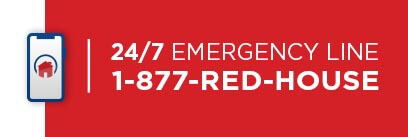
Last Updated: September 7, 2023
You can never be too prepared for storms, and it’s National Preparedness Month! It’s a great time to hone those plans and get informed. As the saying goes, life is what happens to us while we’re busy making other plans.
PREPAREDNESS IS KEY
1. Storms Don’t Wait. Create Your Emergency Plan
If you haven’t already done so, create your Emergency Plan. Determine how you’ll communicate with family before, during, and after a storm or weather event. Communicate the plan with your family and/or staff members and ensure that everyone is informed. If you live near the coast, determine your shelter and evacuation plans. If you’re a business owner, ensure that your employees, vendors and key personnel have copies of your Business Continuity Plan.
2. Gather Supplies
Be sure you have supplies on hand and build your Readiness Kit. Include enough water, food and necessities in case of a power outage. Check out FEMA’s recommended supplies checklist.
3. Understand Your Insurance Policy, Coverage & Deductibles
When is a good time to review your insurance coverage? Now. Know the risk of disasters in your area and what supplemental coverage and policies you may need. Contact your agent if you have questions. Every year, many homeowners realize they’ve purchased inadequate policies and by then, it’s too late. For instance, standard homeowners policies don’t cover flooding. Flood coverage is provided by the federal government’s National Flood Insurance Program and takes 30 days to take effect. Business owners should also review their policies and ensure adequate coverage is in place.
STORM PREPAREDNESS TIPS
Property Preparedness
To mitigate the effects of storm damage, weather and the seasons, it’s important to ensure your property is well maintained.
- Get Routine Property Inspections from a Licensed General Contractor. A comprehensive inspection should include your roofing, siding, exterior structures, gutters, downspouts, fascia and soffits, windows and doors. Often, property owners are not even aware that they have damage.
- Trim Trees & Shrubs. Dead tree limbs can cause severe damage to your home and windows in a storm.
- Clean Your Gutters Regularly. This simple chore can help mitigate water damage to your roofing, siding and foundations.
- Secure Exterior Structures. Ensure that exterior elements such as fences, sheds, and screened enclosures are properly secured to prevent them from being lifted by heavy winds and becoming flying objects in a storm.
- Protect & Strengthen Critical Areas. Your roof, windows, siding, doors and garage doors are all susceptible to extreme wind damage in a storm. Ensure that you have the appropriate supplies on hand during storm season such as shutters or plywood. Remember, the garage door is the most vulnerable part of the home, so it must be able to withstand heavy winds.
Thunderstorm Preparedness: When Thunder Roars, Go Indoors!
Thunderstorms can include powerful winds over 50 mph, along with the potential for lightning, hail, tornadoes, and flash floods. Be prepared! Ensure that you have an annual property maintenance plan in place. Know the difference between a Thunderstorm Watch and Thunderstorm Warning and what to do in each scenario. The best defense against thunderstorms is to stay inside a shelter or sturdy building. If indoors, avoid running water or using landline phones. Electricity can travel through plumbing and phone lines. Listen to authorities and weather forecasts for information on whether it is safe to go outside and alerts for potential flash flooding.
Lightning Preparedness
When possible, avoid the threat when you can. If thunderstorms are expected, cancel or postpone outdoor activities. If you get stuck in a storm, find a sturdy building or stay in a hard-topped vehicle. When inside, stay away from windows and doors. Avoid touching anything plugged in. Lightning can travel through a building’s plumbing during a thunderstorm. Avoid contact with water, including washing dishes and showering.
Hail Storm Preparedness
As our CEO explained on a national media tour discussing 6 Mistakes to Avoid After a Storm, it only takes a wind speed of as little as 58 mph or hail the size of a quarter to cause severe property damage. Be sure to get your property inspected if you think you may have damage. Over 50% of hail claims were made over a year after the hail storm took place, because homeowners did not get their roofs inspected. Remember, state statutes vary to file a claim. And hail damage often goes undetected.
Tornado Preparedness
Understand the difference between a Tornado Watch and Tornado Warning, and what to do in each scenario. It’s important to know the warning signs of a tornado, as you may not receive an official alert. Remember, a tornado’s friends often include hail and lightning, along with the devastating winds than can knock down power lines. For safety, ensure you’re in a sturdy building. During the storm, stay in a small, interior, windowless room, preferably on the lowest level or in the basement. If you have access to a storm shelter or safe room, use it.
Flood Preparedness: Turn Around, Don't Drown®
Annually, flooding causes more deaths than any other hazard related to thunderstorms. Know the difference between a Flash Flood Emergency and a Flash Flood Warning and what to do in each scenario. Floods can occur in every single U.S. state. Turn around, don’t drown! The most common flood deaths occur when a vehicle is driven into hazardous floodwaters. As little as 12 inches of moving floodwater can be enough to make a small vehicle float and carry it away. Just 2 feet of rushing water can sweep away large vehicles, including SUVs and pickup trucks. A mere 6 inches of fast-moving flood water can knock over a full-grown adult.
Storm Surge Preparedness
A not so well-known fact is that storm surge is one of the greatest threats to life and property after a storm. Surge can be caused by all types of storms including thunderstorms, tropical storms, tropical cyclones, hurricanes, Nor’easters and even winter storms. Many areas along the East Coast are particularly vulnerable, even several miles inland from the coastline! If you live in a storm surge evacuation zone, it’s important to know your route and take speedy action. If an evacuation is ordered, don’t delay. Storm surge can cutoff evacuation routes. Even if your area is not affected by storm surge, remember there are other dangerous hazards to watch out for including downed power lines, water and sewage problems, trees and debris blocking the roads. Downed electrical wires can pose a dire risk of electrocution. Stay safe and remember, what you can’t see can hurt you.
Hurricane Preparedness
Hurricane Season in the Atlantic Basin runs from June 1 to November 30 each year. Know the difference between a Hurricane Watch and Hurricane Warning and what to do in each scenario. Preparedness is key! If you’re in a hurricane prone area, know your communication plan, evacuation plan, and be sure to have supplies, food, water, cash, and fuel on hand. Hurricanes can cause major damage including storm surge, wind damage, and flooding. Even areas inland are affected by related storms and potential power outages. According to the Congressional Budget Office, hurricane winds and storm-related flooding cause an annual economic loss of $34 billion to households.
Stay Informed: Monitor Weather Apps
It’s important to download relevant weather apps now, so you’re prepared when you need to be! The FEMA app includes weather alerts, safety tips and disaster resources. Visit Ready.Gov Alerts and learn how to search for local alerts and weather apps that are relevant for hazards that affect your area.
Home Repair: Your Calm After the Storm
As we all know, storm damage is devastating. Whether it’s from wind, hail, heavy rains, floods, tornado or hurricanes, Home Repair, LLC is here to help. As a licensed general contractor with over 30 years of experience, we specialize in roofing, construction, exterior repairs, storm damage restoration, and everything in between. We offer free inspections and expert consultations. We proudly utilize the best materials and latest technology to provide the most advanced level of service to our customers.




